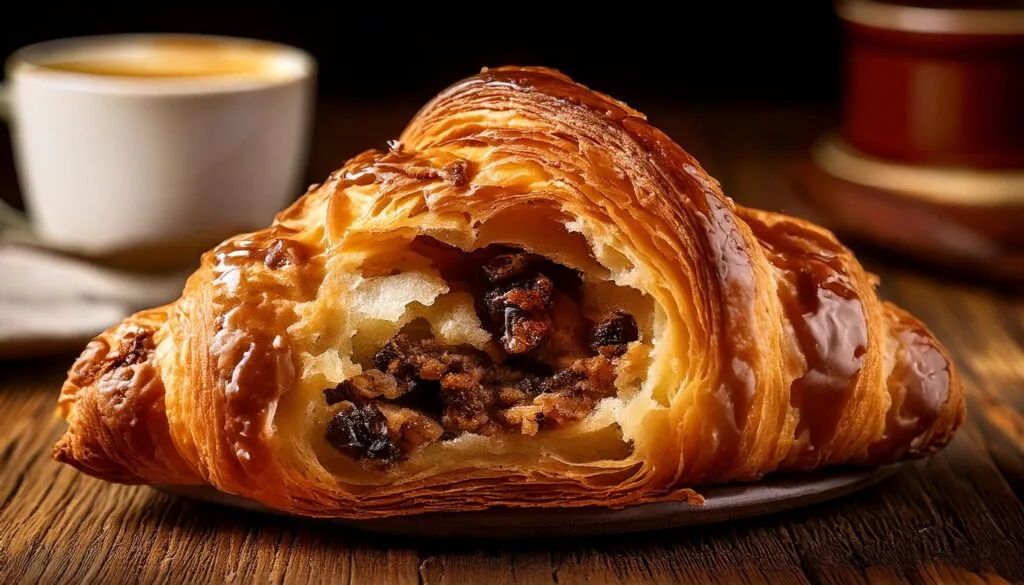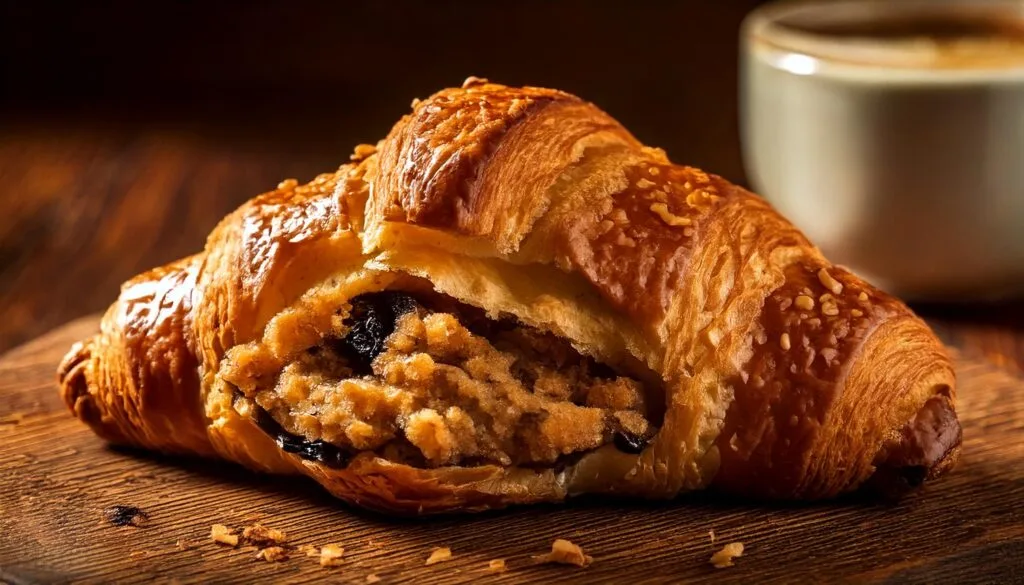Desserts have a way of captivating us, don’t they? Among the ever-growing list of hybrid treats, the crookie stands out as a delicious masterpiece, blending the buttery flakiness of a croissant with the chewy sweetness of a cookie. But where did this ingenious dessert originate? In this article, we’ll uncover the fascinating story behind the crookie, tracing its roots, cultural impact, and rise to fame in bakeries worldwide. Let’s dive into Part 1!
Introduction to the Crookie
The world of desserts has seen countless innovations over the years, from layered cakes to intricate pastries. Yet, the advent of hybrid desserts combining two beloved treats into one has redefined culinary creativity. Among these hybrids, the crookie has earned its spot in the hearts of food lovers everywhere.
What Makes the Crookie Unique?
The crookie, as its name suggests, merges two classics: the airy, buttery texture of a croissant and the rich, dense chewiness of a cookie. This combination creates a dessert that’s both satisfying and innovative a true testament to the endless possibilities of baking.
Why the Origin Story Matters
Every dish has a story, and the crookie is no exception. Exploring its origin helps us appreciate the ingenuity behind its creation and understand how it gained global popularity. After all, desserts aren’t just about taste; they’re about culture, history, and the joy of discovery.
The History of the Crookie
The story of the crookie is a tale of creativity and culinary curiosity. While its exact origin is debated, one thing is clear: this hybrid dessert emerged as part of a growing trend that blended established classics into something entirely new and exciting. Let’s explore the fascinating journey of how this iconic treat came to be.
The Birth of Hybrid Desserts
In recent years, the world of desserts has been dominated by a wave of hybrid creations. From the cronut a croissant-doughnut fusion to dessert pizzas, bakers have been pushing boundaries to redefine the sweet tooth experience. The crookie joined this movement, carving out its niche among dessert enthusiasts who craved something both familiar and innovative.
It all started with the rise of Instagram-worthy desserts. Hybrid treats not only satisfied cravings but also caught eyes with their unique appeal. The crookie, with its flaky layers hugging gooey cookie dough, was destined to thrive in this era of visual food culture.know more about The Hybrid Hype: What Is It All About?
Early Mentions of the Crookie
The first known appearance of the crookie is somewhat murky. While there isn’t a universally accepted inventor, several bakeries have staked their claim. Some argue that small independent bakeries experimented with merging leftover croissant dough and cookie batter as a way to reduce waste, eventually stumbling upon culinary gold.
Others suggest that the crookie may have first gained traction in metropolitan food scenes, particularly in cities like New York and Los Angeles. Here, bakeries often innovate to stand out in competitive markets, making it plausible that the crookie emerged as a local specialty before spreading globally.
The Crookie’s Rise to Fame

The journey of the crookie from an experimental treat to a global sensation is a testament to the power of food trends, social media, and innovation. This section unpacks how the crookie became a cultural phenomenon, winning over the hearts (and taste buds) of dessert lovers worldwide.
How Social Media Boosted the Crookie
In today’s world, no food trend reaches stardom without a little help from platforms like Instagram, TikTok, and Pinterest. The crookie, with its mouthwatering layers and picture-perfect appeal, was a dream come true for food influencers and dessert bloggers. Posts featuring the crookie quickly went viral, showcasing its gooey cookie centers and flaky croissant layers in drool-worthy detail.
Bakeries that introduced the crookie found themselves inundated with customers eager to try the treat they had seen online. Hashtags like #CrookieLove and #DessertHybrid helped fuel its rise, turning this dessert into a worldwide craving.
Celebrity and Media Endorsements
Another pivotal factor in the crookie’s success was endorsements from celebrities and popular media outlets. High-profile figures posting about their love for the crookie brought it into the mainstream, while reviews and features in culinary magazines highlighted its innovative nature. This attention cemented its place as more than just a passing fad it became a dessert worth celebrating.
Bakeries and Cafes Championing the Crookie
Several bakeries have become synonymous with the crookie, crafting unique variations to cater to local tastes. For example:
- In New York, bakeries introduced crookies stuffed with cream cheese frosting.
- Los Angeles food trucks experimented with matcha and chocolate chip flavors.
- Parisian patisseries added a touch of luxury by using premium chocolate and gold leaf decorations.
The creativity of bakers worldwide ensured that the crookie remained fresh and exciting, leading to its sustained popularity.
The Cultural Significance of the Crookie
The crookie isn’t just a dessert it’s a symbol of culinary creativity and global food culture. Beyond its unique flavor and texture, the crookie represents a blend of traditions and modernity, appealing to diverse palates across the world. Let’s explore its cultural impact and how it fits into the broader context of hybrid desserts.
Blending Culinary Traditions
The crookie brings together two iconic elements: the French croissant and the American cookie. This fusion reflects a globalized food culture where influences from different parts of the world come together to create something entirely new. It’s a dessert that celebrates diversity one flaky bite at a time.
For many, enjoying a crookie is an act of nostalgia and novelty. The cookie component evokes childhood memories, while the croissant adds a sophisticated, buttery flair. Together, they create an experience that’s both comforting and exciting.
A Staple in Urban Food Trends
In bustling cities like New York, Tokyo, and Melbourne, food trends are often a mix of innovation and presentation. The crookie fits right into this dynamic, offering a treat that is not only delicious but also visually stunning. Urban bakeries have embraced the crookie as a way to attract adventurous foodies and Instagrammers alike.
The Crookie in Popular Culture
The crookie has made its way into movies, TV shows, and social events, solidifying its status as a cultural icon. Whether it’s served at upscale bakeries or casual coffee shops, the crookie symbolizes indulgence and the joy of discovering something new.
How the Crookie is Made
Behind every crookie is a process that combines artistry, precision, and a touch of experimentation. Crafting this hybrid dessert requires bakers to seamlessly merge two distinct textures and flavors into one unforgettable bite. Here’s a look at how the magic happens.
Key Ingredients in the Crookie
To make a crookie, bakers start with the fundamentals of each component croissant dough and cookie dough. The ingredients include:
- For the croissant base:
- All-purpose or pastry flour
- Yeast for leavening
- Butter for those signature flaky layers
- A touch of sugar and salt for balance
- For the cookie dough:
- Brown and white sugar for a soft, chewy texture
- Butter to create richness
- Eggs for binding
- Chocolate chips or other mix-ins for flavor
- Vanilla extract to enhance sweetness
The combination of these elements creates a treat that’s both buttery and sweet, flaky and gooey.
The Art of Combining Croissant and Cookie Dough
- Preparing the Croissant Dough: Croissant dough is a laminated dough, meaning it involves layering butter between sheets of dough and folding it multiple times to create those airy layers. This step is time-intensive but critical for achieving the signature flakiness.
- Incorporating Cookie Dough:
Once the croissant dough is ready, portions of cookie dough are carefully folded or placed within the croissant layers. This step requires precision to ensure the flavors blend without overpowering one another. - Shaping and Baking:
The dough is shaped into desired forms, such as crescents or squares, and then baked at the right temperature to achieve a balance crispy golden layers on the outside and soft cookie filling on the inside.
Creative Variations in Recipes
Many bakers have added their own spin to the crookie. Some popular variations include:
- Stuffed Crookies: Filled with Nutella, peanut butter, or cream cheese.
- Flavored Doughs: Matcha or red velvet croissant dough paired with complementary cookie flavors.
- Toppings and Finishes: Sprinkled with sea salt, dipped in chocolate, or drizzled with caramel.
Crookie Variations Around the World

As the crookie has traveled across continents, bakers have infused it with local flavors and cultural touches, making it a truly global dessert. Each variation showcases how this hybrid treat can be adapted to suit diverse culinary traditions while maintaining its delicious essence.
Asian-Inspired Crookies
In many parts of Asia, traditional flavors have been incorporated into the crookie, offering a unique twist:
- Matcha Crookie (Japan): Layers of croissant dough infused with matcha powder, paired with white chocolate cookie dough.
- Ube Crookie (Philippines): Vibrant purple croissant dough made with ube (purple yam) and coconut cookie filling.
- Pandan Crookie (Southeast Asia): A fragrant green pandan croissant with coconut sugar or kaya jam-infused cookie dough.
These variations reflect the region’s love for bright colors and unique, aromatic flavors.
European Crookie Creations
Europe, the birthplace of the croissant, has embraced the crookie with a nod to its pastry heritage:
- Chocolate Hazelnut Crookie (France): Featuring a decadent Nutella-inspired filling.
- Almond Crookie (Italy): Croissant layers enriched with almond paste and biscotti-style cookie dough.
- Black Forest Crookie (Germany): Inspired by the Black Forest cake, filled with cherry preserves and chocolate cookie dough.
European bakeries often elevate the crookie with gourmet touches like high-quality butter and artisanal ingredients.
American-Inspired Twists
The crookie first gained traction in the U.S., and it’s no surprise that American bakers have continued to innovate:
- S’mores Crookie: Marshmallow, graham cracker, and chocolate cookie dough for a campfire-inspired treat.
- Peanut Butter & Jelly Crookie: A nostalgic take combining peanut butter cookie dough and fruit preserves.
- Caramel Pecan Crookie: Croissant dough layered with caramel and crunchy pecan-studded cookie dough.
American crookies often focus on indulgence, with bold flavors and decadent fillings.
FAQs About Crookies
Curiosity around the crookie has sparked plenty of questions, from how it’s made to its nutritional content. Below are answers to some of the most frequently asked questions about this unique hybrid dessert.
1. What is a crookie made of?
A crookie combines croissant dough and cookie dough. The croissant dough provides the flaky layers, while the cookie dough adds a rich, sweet, and chewy center or topping. Optional variations may include additional fillings like Nutella, fruit preserves, or flavored creams.The Ultimate Crookie Recipe: A Delectable Fusion of Cookies and Croissants
2. Where did the crookie originate?
The crookie is widely believed to have emerged in the U.S., where hybrid desserts like the cronut and brookie (brownie-cookie) became trendy. Though specific origins may vary, it gained traction in urban bakeries known for creating viral, photogenic treats.
3. How is a crookie different from a cronut?
While both are hybrid desserts involving croissant dough, the cronut incorporates donut characteristics (deep-frying and glaze). In contrast, the crookie involves baking and features cookie dough as its signature component.
4. Are crookies difficult to make at home?
Yes, the crookie can be challenging to make at home because it requires expertise in laminating croissant dough and combining it with cookie dough in a way that maintains both textures. However, pre-made croissant dough and cookie dough simplify the process for home bakers.
5. Are crookies healthy?
Like most desserts, crookies are best enjoyed as an occasional indulgence. Their calorie content depends on the recipe, but the combination of buttery croissant dough and sugary cookie dough makes them high in fats and sugars.
6. Can crookies be customized for dietary restrictions?
Absolutely! Bakers can create gluten-free versions using alternative flours, vegan crookies by swapping butter and eggs with plant-based substitutes, and low-sugar crookies by using natural sweeteners like stevia.
7. Why are crookies so popular?
The crookie is popular because it combines two beloved desserts, making it a double treat. Its unique texture and flavor combinations also appeal to adventurous eaters and dessert enthusiasts, while its eye-catching appearance makes it Instagram-worthy.
Part 6: Conclusion
The crookie is more than just a dessert; it’s a testament to how creativity and innovation can transform simple ingredients into something extraordinary. From its mysterious origins to its diverse global variations, the crookie has captured the hearts (and stomachs) of food lovers worldwide. Whether you savor it as a quick snack, a celebratory treat, or an experimental project in the kitchen, the crookie continues to redefine what it means to enjoy dessert.
So next time you take a bite of this flaky, gooey delight, remember the journey it represents a fusion of flavors, cultures, and culinary imagination. And, of course, don’t forget to share your crookie experience with friends and family! Who knows? You might inspire someone else to fall in love with this iconic hybrid treat.
